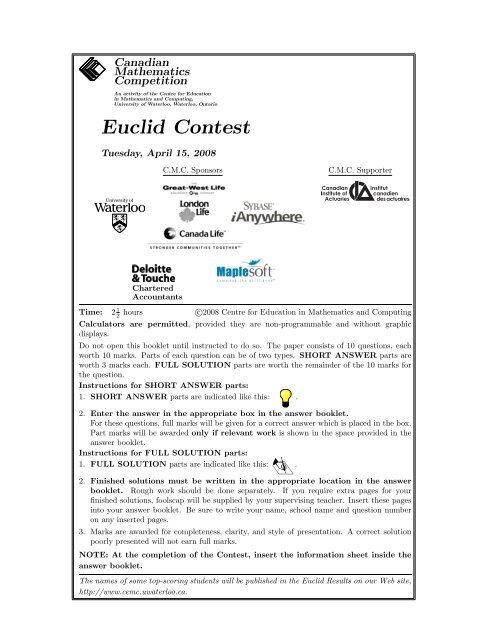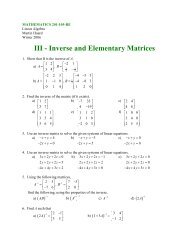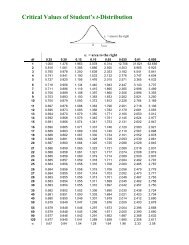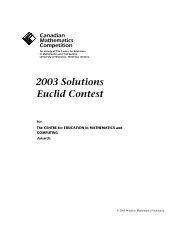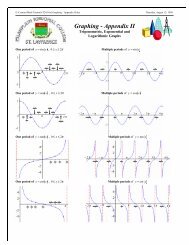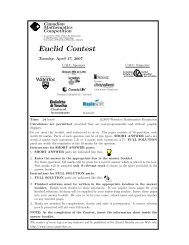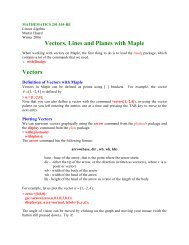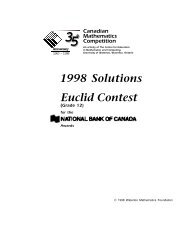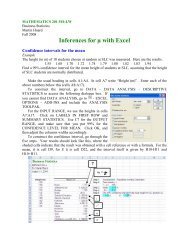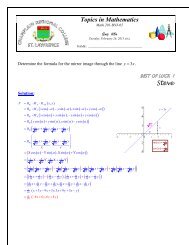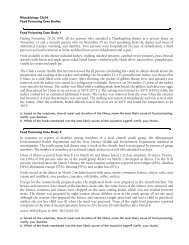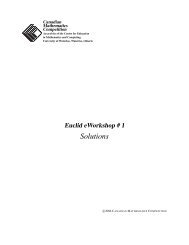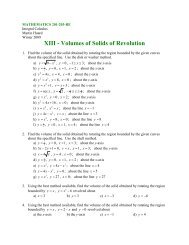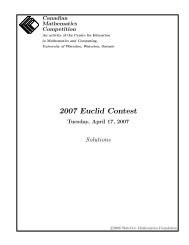Euclid Contest 2008 - CEMC - University of Waterloo
Euclid Contest 2008 - CEMC - University of Waterloo
Euclid Contest 2008 - CEMC - University of Waterloo
You also want an ePaper? Increase the reach of your titles
YUMPU automatically turns print PDFs into web optimized ePapers that Google loves.
Canadian<br />
Mathematics<br />
Competition<br />
An activity <strong>of</strong> the Centre for Education<br />
in Mathematics and Computing,<br />
<strong>University</strong> <strong>of</strong> <strong>Waterloo</strong>, <strong>Waterloo</strong>, Ontario<br />
<strong>Euclid</strong> <strong>Contest</strong><br />
Tuesday, April 15, <strong>2008</strong><br />
C.M.C. Sponsors<br />
C.M.C. Supporter<br />
Chartered<br />
Accountants<br />
Time: 2 1 2<br />
hours c○<strong>2008</strong> Centre for Education in Mathematics and Computing<br />
Calculators are permitted, provided they are non-programmable and without graphic<br />
displays.<br />
Do not open this booklet until instructed to do so. The paper consists <strong>of</strong> 10 questions, each<br />
worth 10 marks. Parts <strong>of</strong> each question can be <strong>of</strong> two types. SHORT ANSWER parts are<br />
worth 3 marks each. FULL SOLUTION parts are worth the remainder <strong>of</strong> the 10 marks for<br />
the question.<br />
Instructions for SHORT ANSWER parts:<br />
1. SHORT ANSWER parts are indicated like this: .<br />
2. Enter the answer in the appropriate box in the answer booklet.<br />
For these questions, full marks will be given for a correct answer which is placed in the box.<br />
Part marks will be awarded only if relevant work is shown in the space provided in the<br />
answer booklet.<br />
Instructions for FULL SOLUTION parts:<br />
1. FULL SOLUTION parts are indicated like this: .<br />
2. Finished solutions must be written in the appropriate location in the answer<br />
booklet. Rough work should be done separately. If you require extra pages for your<br />
finished solutions, foolscap will be supplied by your supervising teacher. Insert these pages<br />
into your answer booklet. Be sure to write your name, school name and question number<br />
on any inserted pages.<br />
3. Marks are awarded for completeness, clarity, and style <strong>of</strong> presentation. A correct solution<br />
poorly presented will not earn full marks.<br />
NOTE: At the completion <strong>of</strong> the <strong>Contest</strong>, insert the information sheet inside the<br />
answer booklet.<br />
The names <strong>of</strong> some top-scoring students will be published in the <strong>Euclid</strong> Results on our Web site,<br />
http://www.cemc.uwaterloo.ca.
NOTES: 1. Please read the instructions on the front cover <strong>of</strong> this booklet.<br />
2. Write all answers in the answer booklet provided.<br />
3. For questions marked “ ”, full marks will be given for a correct answer<br />
placed in the appropriate box in the answer booklet. If an incorrect answer<br />
is given, marks may be given for work shown. Students are strongly<br />
encouraged to show their work.<br />
4. All calculations and answers should be expressed as exact numbers such as<br />
4π, 2+ √ 7, etc., rather than as 12.566 . . . or 4.646 . . ., except where otherwise<br />
indicated.<br />
A Note about Writing Solutions<br />
For each problem marked “ ”, a full solution is required. The solutions that<br />
you provide in the answer booklet should be well organized and contain a balance <strong>of</strong><br />
mathematical statements and words <strong>of</strong> explanation. Working out some <strong>of</strong> the details in<br />
rough on a separate piece <strong>of</strong> paper before writing your finished solution is a good idea.<br />
Your final solution should be written so that the marker can understand your approach<br />
to the problem and all <strong>of</strong> the mathematical steps <strong>of</strong> your solution.<br />
1. (a) In the diagram, what is the perimeter <strong>of</strong><br />
△ABC?<br />
A<br />
12<br />
20<br />
(b) In the diagram, the line segment with<br />
endpoints (a, 0) and (8, b) has midpoint (5, 4).<br />
What are the values <strong>of</strong> a and b?<br />
B<br />
y<br />
9<br />
D<br />
(8, b)<br />
C<br />
(5, 4)<br />
O<br />
(a, 0)<br />
x<br />
(c) The lines ax + y = 30 and x + ay = k intersect at the point P (6, 12). Determine<br />
the value <strong>of</strong> k.<br />
2. Each part <strong>of</strong> this problem refers to the parabola y = (x − 2)(x − 8) + 7.<br />
(a) The points (2, 7) and (c, 7), where c ≠ 2, lie on the parabola. What is the value<br />
<strong>of</strong> c?<br />
(b) What are the coordinates <strong>of</strong> the vertex <strong>of</strong> the parabola?<br />
(c) A line that passes through the point A(5, 0) intersects the parabola at B(4, −1).<br />
Determine the other point at which this line intersects the parabola.
3. (a) A 3 × 3 square frame is placed on a grid<br />
<strong>of</strong> numbers, as shown. In the example, the<br />
sum <strong>of</strong> the numbers inside the square frame<br />
is 108, and the middle number is 12. When<br />
the square frame is moved to a new position,<br />
the sum <strong>of</strong> its numbers becomes 279. In<br />
the frame’s new position, what is the middle<br />
number?<br />
1 2 3 4 5 6 7<br />
8 9 10 11 12 13 14<br />
15 16 17 18 19 20 21<br />
22 23 24 25 26 27 28<br />
29 30 31 32 33 34 35<br />
36 37 38 39 40 41 42<br />
43 44 45 46 47 48 49<br />
(b) Of the three figures shown, which has the smallest area and which has the largest<br />
area? Explain how you determined your answer. (In Figure A, the circle has a<br />
diameter <strong>of</strong> length 2.)<br />
Figure A<br />
Figure B<br />
Figure C<br />
2<br />
2<br />
2<br />
4. (a) A flagpole F P is 20 metres tall. From point<br />
A on the flat ground, the angle <strong>of</strong> elevation to<br />
the top <strong>of</strong> the flagpole is 40 ◦ . If B is halfway<br />
from A to F , what is the measure <strong>of</strong> ∠F BP ,<br />
to the nearest degree?<br />
P<br />
40<br />
A B F<br />
(b) In the diagram, AB = 21 and BC = 16.<br />
Also, ∠ABC = 60 ◦ , ∠CAD = 30 ◦ , and<br />
∠ACD = 45 ◦ . Determine the length <strong>of</strong> CD,<br />
to the nearest tenth.<br />
16<br />
C<br />
45<br />
D<br />
30<br />
B<br />
60<br />
21<br />
A<br />
5. (a) In the diagram, the large circle has radius 9<br />
and centre C(15, 0). The small circles have<br />
radius 4 and centres A and B on the<br />
horizontal line y = 12. Each <strong>of</strong> the two small<br />
circles is tangent to the large circle. It takes<br />
a bug 5 seconds to walk at a constant speed<br />
from A to B along the line y = 12. How far<br />
does the bug walk in 1 second?<br />
y<br />
O<br />
A<br />
B<br />
C (15, 0)<br />
y =12<br />
x
(b) Determine all values <strong>of</strong> k, with k ≠ 0, for which the parabola<br />
has its vertex on the x-axis.<br />
y = kx 2 + (5k + 3)x + (6k + 5)<br />
6. (a) The function f(x) satisfies the equation f(x) = f(x − 1) + f(x + 1) for all values<br />
<strong>of</strong> x. If f(1) = 1 and f(2) = 3, what is the value <strong>of</strong> f(<strong>2008</strong>)?<br />
(b) The numbers a, b, c, in that order, form a three term arithmetic sequence (see<br />
below) and a + b + c = 60.<br />
The numbers a − 2, b, c + 3, in that order, form a three term geometric sequence.<br />
Determine all possible values <strong>of</strong> a, b and c.<br />
(An arithmetic sequence is a sequence in which each term after the first is<br />
obtained from the previous term by adding a constant. For example, 3, 5, 7 is<br />
an arithmetic sequence with three terms.<br />
A geometric sequence is a sequence in which each term after the first is obtained<br />
from the previous term by multiplying it by a constant. For example, 3, 6, 12 is<br />
a geometric sequence with three terms.)<br />
7. (a) The average <strong>of</strong> three consecutive multiples <strong>of</strong> 3 is a.<br />
The average <strong>of</strong> four consecutive multiples <strong>of</strong> 4 is a + 27.<br />
The average <strong>of</strong> the smallest and largest <strong>of</strong> these seven integers is 42.<br />
Determine the value <strong>of</strong> a.<br />
(b) Billy and Crystal each have a bag <strong>of</strong> 9 balls. The balls in each bag are numbered<br />
from 1 to 9. Billy and Crystal each remove one ball from their own bag. Let b be<br />
the sum <strong>of</strong> the numbers on the balls remaining in Billy’s bag. Let c be the sum <strong>of</strong><br />
the numbers on the balls remaining in Crystal’s bag. Determine the probability<br />
that b and c differ by a multiple <strong>of</strong> 4.<br />
8. (a) Points A, B, C, and D are arranged, as<br />
shown, with AB parallel to DC and P the<br />
point <strong>of</strong> intersection <strong>of</strong> AC and BD. Also,<br />
∠ACB = 90 ◦ , AC = CB, AB = BD = 2.<br />
Determine the measure <strong>of</strong> ∠DBC.<br />
A<br />
D<br />
P<br />
C<br />
2<br />
B<br />
(b) In the diagram, ABC is a right-angled<br />
triangle with P and R on AB. Also, Q is on<br />
AC, and P Q is parallel to BC. If RP = 2,<br />
BR = 3, BC = 4, and the area <strong>of</strong> △QRC<br />
is 5, determine the length <strong>of</strong> AP .<br />
C<br />
4<br />
Q<br />
B<br />
3 R 2<br />
P<br />
A
9. (a) The equation 2 x+2 5 6−x = 10 x2 has two real solutions. Determine these two<br />
solutions.<br />
(b) Determine all real solutions to the system <strong>of</strong> equations<br />
x + log 10 x = y − 1<br />
y + log 10 (y − 1) = z − 1<br />
z + log 10 (z − 2) = x + 2<br />
and prove that there are no more solutions.<br />
10. Suppose that n is a positive integer. Consider an upward-pointing equilateral<br />
triangle <strong>of</strong> side length n, cut up into unit triangles, as shown.<br />
n = 3 n = 4<br />
For each n, let f(n) represent the total number <strong>of</strong> downward-pointing equilateral<br />
triangles <strong>of</strong> all sizes. For example, f(3) = 3 and f(4) = 6 + 1 = 7, as illustrated<br />
below.<br />
n = 3 n = 4<br />
f(3) = 3 f(4) = 6 + 1 = 7<br />
(a) Determine the values <strong>of</strong> f(5) and f(6).<br />
(b) Prove that f(2k) = f(2k − 1) + k 2 for each positive integer k ≥ 1.<br />
(c) Determine, with justification, all positive integers n for which f(n) is divisible<br />
by n.
<strong>2008</strong><br />
<strong>Euclid</strong><br />
<strong>Contest</strong><br />
(English)<br />
For students...<br />
Canadian Mathematics Competition<br />
Thank you for writing the <strong>2008</strong> <strong>Euclid</strong> <strong>Contest</strong>!<br />
In 2007, more than 14 000 students from around the world<br />
registered to write the <strong>Euclid</strong> <strong>Contest</strong>.<br />
If you are graduating from secondary school, good luck<br />
in your future endeavours!<br />
If you will be returning to secondary school next year,<br />
encourage your teacher to register you for the <strong>2008</strong> Sun Life<br />
Financial Canadian Open Mathematics Challenge, which will<br />
be written in late November.<br />
Visit our website<br />
www.cemc.uwaterloo.ca<br />
to find<br />
• More information about the Sun Life Financial Canadian<br />
Open Mathematics Challenge<br />
• Free copies <strong>of</strong> past contests<br />
• Workshops to help you prepare for future contests<br />
• Information about our publications for mathematics<br />
enrichment and contest preparation<br />
• Information about careers in mathematics<br />
For teachers...<br />
Visit our website<br />
to<br />
www.cemc.uwaterloo.ca<br />
• Obtain information about our <strong>2008</strong>/2009 contests<br />
• Learn about workshops and resources we <strong>of</strong>fer for<br />
teachers<br />
• Find your school results


